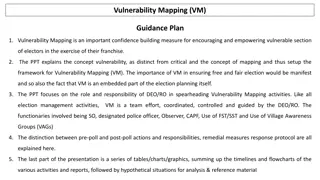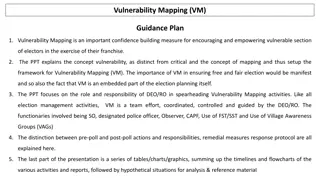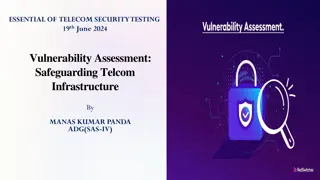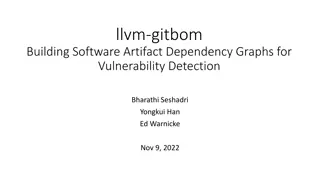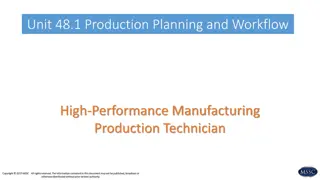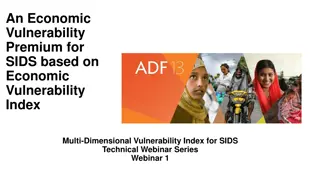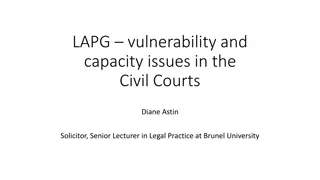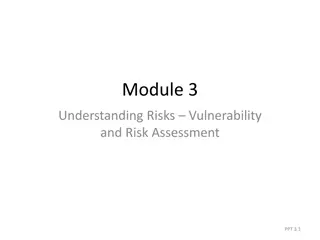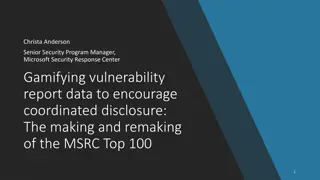Effective Workflow for Vulnerability Research in Production Environments
Professional vulnerability research involves finding bugs efficiently through fuzzing techniques. The main goal is to develop a comprehensive workflow and toolset for effective bug discovery and triaging. Ancillary goals focus on determining exploitability, optimizing human and CPU efficiency, and ensuring ease of use. The process breakdown includes attack surface analysis, input selection, fuzzing, and triage. Key factors for successful fuzzing and bug triaging include smart input selection, time management, automation, distributed fuzzing, crash analysis, and confidence rating.
Download Presentation

Please find below an Image/Link to download the presentation.
The content on the website is provided AS IS for your information and personal use only. It may not be sold, licensed, or shared on other websites without obtaining consent from the author.If you encounter any issues during the download, it is possible that the publisher has removed the file from their server.
You are allowed to download the files provided on this website for personal or commercial use, subject to the condition that they are used lawfully. All files are the property of their respective owners.
The content on the website is provided AS IS for your information and personal use only. It may not be sold, licensed, or shared on other websites without obtaining consent from the author.
E N D
Presentation Transcript
Harder, Better, Faster, Stronger Semi-Auto Vulnerability Research 1
Professional Vulnerability Research Finding bugs is not the problem Fuzzing works Microsoft found over 1800 bugs in Office 2010 http://blogs.technet.com/b/office2010/archive/2010/05/11/how-the-sdl-helped-improve- security-in-office-2010.aspx 280 bugs found in Mozilla JavaScript using JSFunFuzz https://bugzilla.mozilla.org/show_bug.cgi?id=jsfunfuzz Tooling is not the problem Distributed fuzzing Crash analyzers Lack of intelligent workflow is the problem 2
Main Goal Develop an effective workflow and toolset for fuzzing and triaging vulnerabilities in a production environment 3
Ancillary Goals Primary Determine cause and exploitability Human time efficiency Secondary CPU efficiency Ease of use 4
Process Breakdown Attack Surface Analysis Input Selection Fuzzing Triage 5
Keys to Fuzzing Smartly Input selection Most important factor in timely bug discovery Time management Automation SIMPLE Distributed fuzzing Crash analysis Bucketing Confidence Rating 6
Keys to Smart Bug Triage Crash selection Select for understanding Crash database Bug classes Program flow analysis Code coverage Input Mapping Taint Analysis 7
Input Selection Attack Surface Analysis Determine which areas of the code are reachable from external inputs Template code coverage Determine what areas of code are exercised by different templates Rank templates based upon coverage of targeted code or overall attack surface 8
Fuzzing The Miller Theorem C C = code path coverage = code path coverage T = T = Time spent Fuzzing Time spent Fuzzing B B = Bugs Discovered = Bugs Discovered ?? ?? = ?? 9
Fuzzing Obey the Miller Theorem Create inputs to maximize coverage Create the framework to maximize uptime Generation vs. Mutation If you can, do both! Mutation is cheaper, still works Do as little work as possible Re-do as little work as possible 10
Fuzzing Test Execution Data Collection Retesting 11
Fuzzing Test Execution Watch your tests well Embedded custom debugger Be able to gather needed data at crash time Make use of debugging technologies Be able to avoid invalid exceptions Distribute your tests Centralized management Make it easy to add nodes 12
Fuzzing Data Storage Use a database! Store lots of data over time Easily searched What to store Store what you need for crash selection All crash information Software versioning information Binary diffs 13
Fuzzing - Retesting Maintaining a good database allows: Automated retesting of modified code paths Automated retesting of crashes in modified code paths Track bug life across software versions A bug which lives through a nearby patch can have a long shelf-life MS08-067 and MS06-040 ANI 14
Triage Crash Selection Which crashes should receive priority? What properties make crashes more exploitable? Knowledge! Familiarity! Crash database Vulnerability properties Searchable crash criteria 15
Triage Crash Selection Exception Analysis Determine level of access exception grants user Bug Class Identification Difficulty of exploitability varies by bug class Custom architecture problems Custom memory allocators 16
Triage Program Flow Analysis Abstract a program into flows Code execution Data dependency Code Coverage Block hit trace for path to exception Build a graph of program execution Augment static program graphs 17
Triage Program Flow Analysis Input Mapping Trace APIs or System Calls that perform I/O Mark data copied from external sources into memory Taint analysis Follow input through the execution of the program Determine where the bytes of the crash originated Potential for exploit and signature generation 18
Triage Program Flow Analysis Visualization Provides a graphical representation of program structure and execution paths Visualization allows overlaying multiple graphs and datasets using visual cues Converting data to a visual problem allows rapid understanding of large datasets 19
Moflow 20
[Moflow.png] 22
Input Selection - Requirements Attack Surface Analysis Call graph analysis Template code coverage Dynamic tracing Template ranking Coverage graph analysis 24
Attack Surface Analysis Obtain call graph IDA2Moflow.idc LibCodis Define APIs that are data entry points Input Source I/O API File NtOpenFile() NtCreateFile() SYS_Open() NtReadFile() NtWriteFile() SYS_Read() SYS_Write() Network connect() accept() send() recv() 25
Attack Surface Analysis Determine reachability graph from each API -wavefront RootSet closure While nonEmpty( -wavefront) Do wavefront oneStep( -wavefront) -wavefront wavefront closure closure closure -wavefront End While Return closure -wavefront Algorithm Qadah et al. 26
Template Code Coverage Dynamic Tracing Instrument each basic block in a program Efficiently record execution order of all blocks Implementation - PinFlow Program tracer written as a PinTool Hook on block cache creation Inject instructions into cached code blocks Callback function writes binary struct to ringbuffer Ringbuffer flushed when full and on program exit 27
Template Code Coverage Moflow Visualizer PinFlow Trace Launcher 28
Template Code Coverage Advantage Speed PIN is much faster than traditional breakpoint or trap based solutions 7zip Benchmark Test Block Tracer Process Stalker PinFlow Time (sec) 20.48 1.77 11.57 times faster! 29
Template Prioritization Select functions for attack surface Calculate reachability to create attack surface graph Rank stored traces by number of nodes hit in attack surface graph 30
Template Prioritization [TraceRank.png] 31
Graph Visualization Moflow Block Trace Graph Visualization [Graph 1] 32
Fuzzing Automation Distributed Fuzzing Fuzzer Management Data Gathering Crash Mining 34
Distributed Fuzzing Tests are small and atomic Distribute simply Make it easy to add systems Easy to add tests Centralized Management Aids in speedy addition of hardware 35
Fuzzer Management Customizable yet simple Ignore first chance exceptions? Add debugging technologies? Max test case timeout Ease of use is key Quick recovery for dead hosts Quick addition of new hosts Centralized management w/ database 36
Fuzzer Management Jobs are held in the central DB Job details passed to workers Test cases are generated by workers as needed Successful crashes are returned to the DB with details Test cases are wrapped with a custom debugger Data is returned to the central DB 37
Basic Worker Job Collection (curl -> sql database) Fuzzing Engine (anything you like!) Debugged Test Thread (dbgext) CPU Monitor (WBEM) Data Reporting (curl -> sql database) Data Collection (Codis, dbgext) 38
Data Gathering Store what you must Bucketing Categorization Indicators of Exploitability Store what you have Why redo work? Can t know what you may need Store it smart Database! 39
Crash Mining Post-crash analysis is performed on crashes deemed relevant Relevant crashes are those which are: Familiar to your exploit developers Relate to your attacking goals Relevant crashes are mined as needed from the database with queries. What is relevant changes over time. 40
Triage - Requirements Exploitability Exception information Deep Trace Triggering Condition Fuzzer feedback Taint analysis Root Cause Graph analysis 43
Triage - Exploitability Exception Information Brutefile outputs XML data containing exception information Deep Trace Code Coverage Attack surface APIs Dataflow 44
Triage - Exploitability Dataflow Once exception is found program is traced using PinFlow to gather instruction level instrumentation Blocks are hooked during cache and disassembled to instrument instructions that access memory Dataflow callback function records the address and value of each memory read or write Taint Analysis Provides exception analysis functions with information about controlled bytes Knowledge of controlled bytes allows more precise analysis 45
Triage Triggering Condition Fuzzer Feedback As part of exception analysis data Brutefile includes information about mutation Taint analysis When triaging a bug from input with unknown modifications, perform taint analysis Forward taint propagation from memory allocated to stored data from input file will reveal which bytes are referenced in the exception 46
Triage Root Cause Graph Analysis Overlay graphs of several deep traces to determine similarity If execution trace leading up to the crash is identical but different bytes were manipulated, root cause should be determined Taint analysis Follow tainted data in the exception back to the code location that first influenced the memory location with external data 47
Console Disassembler Console interface for libcodis Static Analysis Instruction Disassembly Function Detection Code and Data Cross-References Function Control Flow Graph Call Graph Import IDA2Moflow and .map files 49
Windbg Integration CodisExt Windbg extension using the engextcpp API Utilizes libcodis to extract disassembly graphs and cross-references Utilizes Windbg DML functionality to allow a hyperlinked interface for cross references 50




